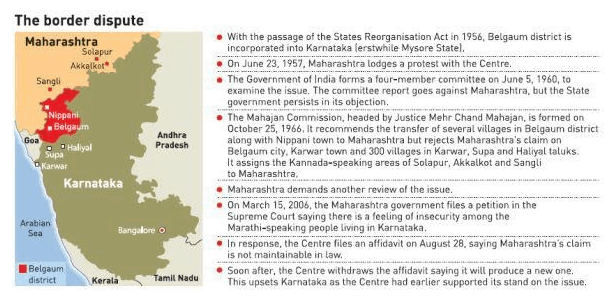UPSC Articles
HISTORY
TOPIC: General Studies 1:
- Post-independence consolidation and reorganization within the country
Inter- state border dispute : Maharashtra-Karnataka Belgaum tension (Part-1)
In news:
- Recently Bus services between Kolhapur and Belgaum were suspended after the decades-old border dispute between Maharashtra and Karnataka flared up again.
- Various Kannada organisations had staged a protest in Belgaum and burnt the effigy of Maharashtra Chief Minister Uddhav Thackeray.
Do you know?
- The dispute between Maharashtra and Karnataka over Belgaum and other border areas is a longstanding issue between the two states, and has been pending before the Supreme Court for many years.

Daily Current Affairs IAS | UPSC Prelims and Mains Exam – 31st December 2019
History:
- In 1947, the Belgaum district became a part of the Bombay State.
- In 1948, the Belgaum Municipality that was dominated by Marathi speaking politicians requested Indian Constituent Assembly and the Boundary Commission to include the Belgaum in the proposed Maharashtra state for the Marathi speakers.
- In accordance to the established policy of bifurcation on linguistic majority basis, in 1956, the Belgaum district was incorporated into the newly formed Mysore state (now Karnataka) with the passage of the States Reorganisation Act(The Act, reorganised India’s states along linguistic and administrative lines)
- Adjoining areas which had majority of Marathi speaking citizens were included in the newly formed Maharashtra state. included Belgaum in the Kannada-majority Karnataka, the district had most of the Marathi-speaking population hence the ‘dispute’ arised.
Data:
- In the 1881 census, Belgaum had 864,014 people of which 556,397 were Kannada-speaking (64.39%), while 225,008 were Marathi-speaking (26.04%)
Mahajan committee:
- The Government of India constituted Mahajan Committee in 1960 to look into the case,But it failed to reach an agreement
Summary of the Mahajan committee report:
- Belgaum to continue in Karnataka
- Around 247 villages/places including Jatta, Akkalakote, Sholapur to be part of Karnataka
- Around 264 villages/places including Nandagad, Nippani Khanapur to be part of Maharashtra
- Kasaragod (of Kerala) to be part of Karnataka
Response to the report:
- The Maharashtra and Kerala government refuted the recommendations of the report and demanded another review of the issue.
- Maharashtra government termed the findings of the reports as biased and self-contradictory because the “formula” applied for Kasaragod was not applied for Belgaum.
- Maharashtra Government insisted that the report is against the “wish of people” of Belgaum.
- Kerala, on the other hand, refused to hand over Kasaragod to Karnataka. The Karnataka government, continued to press for the implementation of the report or maintaining status quo.
What Maharashtra wanted?
Maharashtra wanted to apply following points and agreed to hand over Kannada majority villages to Karnataka:
- Villages as a unit
- Geographical proximity/integrity
- Marathi or Kannada speakers “relative majority”; in case of villages with no population, it should be merged with that state where the owners of that land reside
- People’s wish
Karnataka Government, wanted status quo to be maintained.
Connecting the dots:
- Do you think this dispute is detrimental for the integrity of the country?
- How do you think the dispute can be resolved?














